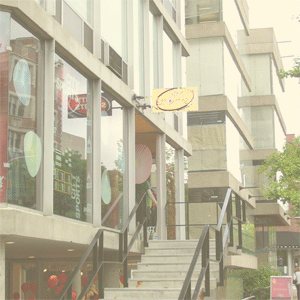 |
|||

|
Cambridge, after the Second World War, developed as the transplanted center of the modernist movement in architecture. The Harvard Graduate School of Design became a haven for architects fleeing the increasingly precarious political climate of Europe. The newly-arrived generation of professors replaced the Beaux-Arts tradition with the modernist ideas of sleek form, ultimate function, and elegant design. David Fixler has titled the unique culture that soon developed as “Cambridge Modern.” Fixler identifies the presence and work of important modernist architects and thinkers such as Benjamin Thompson, Marcel Breuer, Le Corbusier, and Josep Lluis Sert, to name only a small few, who created an atmosphere of modernism in Cambridge unlike any other. Perhaps the biggest of the modernist celebrities who came to Cambridge was Walter Gropius, the founder of the famed Bauhaus in Germany. Gropius arrived at the Harvard Graduate School of Design on March 30, 1937 as the Chairmen of the Department of Architecture. While much of the innovation of the new architectural style originated in Europe, Cambridge was home to an innovation in the nature of the architectural practice. Gropius built his personal home in Lincoln, Massachusetts (now a national historic site and museum) but his architecture career remained firmly centered on Cambridge. His innovation in the field of architecture came in 1945, as Gropius became a founding member of The Architects' Collaborative (TAC). The TAC united Gropius with seven other younger, but leading architects of his era: Benjamin Thompson, John C. Harkness, Sarah P. Harkness, Norman C. Fletcher, Jean B. Fletcher, Robert S. McMillan, and Louis A. McMillan. John and Sarah Harkness would remain with the TAC for its entire 50-year existence. Together, they designed a number of buildings, with public schools and hospitals becoming a specialty. The innovation that the TAC embraced and expounded was the idea of collaboration over individualism in design to produce the best product. The structure of the TAC was a partner-in-charge as the leader of individual projects, but the entire group would to discuss all of the projects they were working on. As the firm grew, it became inefficient for all of the architects to meet together, but smaller teams of architects preserved the collaborative nature of the original approach. The TAC's unique method of architectural practice reflects a new philosophy of design as embodied by its architects. Norman and Jean Fletcher wrote to Gropius when first considering joining the TAC, and reveal the true innovation behind the vision: “Thus our aims become, not architecture for architecture's sake, but architecture for the sake of a healthy society.” (Gropius book pg. 256). Gropius himself saw the modernist movement as part of the creation of a new, and better society. He explained, “I want to make young people realize how inexhaustible the means of creation are if they make use of the innumerable modern products of our age, and to encourage these young people in finding their own solutions.” The TAC worked around the United States and the world.
They did leave their mark indelibly in Cambridge, with two important buildings. One is their office headquarters, pictured above. The other was the new Graduate Center built at Harvard in 1949. Gropius left the TAC in 1965 at the age of 82. The group continued on, but the firm fell into financial difficulties in the 1980s and was officially closed in 1995. While the innovative process the TAC architects believed so deeply in did not become the norm for architectural firms, they did become one of the fist to design environmentally sound buildings in the 1980s, and their message and unique approached added to the creative world of Cambridge Modern. Important Works
|
||

